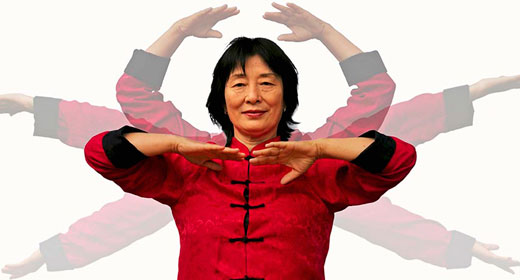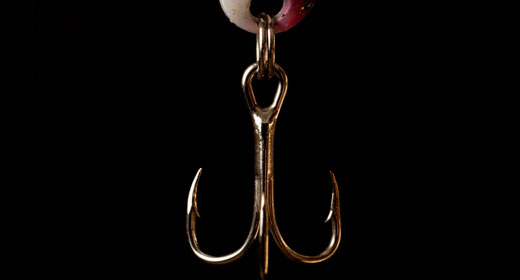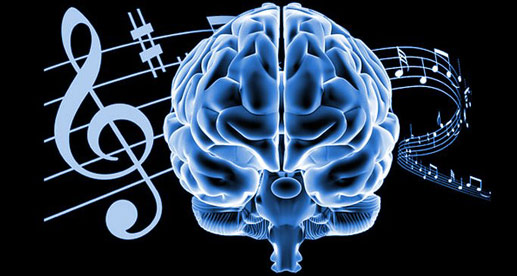by Fritz Perl: How can we fail to project ourselves into each and every dream thought? When we dream of our mothers, for example, is that dream image– as vivid and lifelike 
as it may be – really our mother?Is it really her words or script? Of course not.
This tendency to project, however, is so strong that we often fail to realize we
have done so. Freud postulated that projection was an unconscious ego defense,
where we take unwanted or undesired self-traits and attribute them to others.
Because the process takes place so quickly and automatically, we remain unaware
that projection has even taken place.
I will give some examples. The first is a demonstration that has never failed in An introduction to Fritz Perls’ dream interpretation techniques my general psychology class for over two decades. Look at the following two figures:
Now, decide which one is happy and which one is out on parole for murder.
Without any additional instructions and without any hesitation, 95% or more
of every class decides that the circle is happy and the triangle is murderous. Then
I stare at them in disbelief, while they typically giggle at their own folly. People,
I say to them, these are drawings of chalk on a blackboard (or black ink on a
whiteboard). They are not alive! They have no feelings, neither happy ones nor
murderous ones. Then I point out that if they can project personality traits that
easily upon the simplest of chalk drawings, imagine how more complicated our
projections could be upon vivid dream images, and that includes both animate
and inanimate images.
Another common example of projection occurs when we anthropomorphize
(attaching human attributes to nonhuman things or animals). There was an
eloquent story in a nonscientific magazine of a person who observed a funeral
procession…among ants. The author courageously told the story of how the dead
little worker ant was held aloft by its comrades in a solemn procession, carried
sadly out of the main hole, and down the sides of the hill. Although scientists
are not absolutely certain, it does not appear that ants are capable of anywhere
near the same emotional sadness that humans feel. Furthermore, studies have
shown that ants simply find the smell of a dead ant aversive (apparently the smell
arises from decaying acids). In fact, if you take the decaying chemical and spray
it on a live ant, that live ant will also be held aloft by its comrades and carried
out of the anthill. People frequently anthropomorphize their pets, but it can be
done as well with plants, cars, houses, or sports equipment. Again, if we can
anthropomorphize animals, plants, or material possessions, imagine how easy
it is for humans to attribute their own personality traits onto the vivid images
in their dreams.
The modern discipline of behavior genetics has also shown that the largest
factor contributing to the total sum of an individual’s behavior comes from
genetically based temperaments (e.g. Turkheimer, 2000). These temperaments
are also mostly consistent across various situations and across one’s lifespan (e.g.
Heatherton and Weinberger, 1994). I believe that both factors may operate
during dreaming. We probably project many of our deepest prejudices, biases,
and offensive proclivities into our dream cast, script, and surroundings. Our
dream themes will also be profoundly shaped by our ingrained, genetic
predispositions to act and see ourselves act in very particular ways. Also, notice
how these ingrained, genetic predispositions are consonant with Jung’s notions
of archetypes impelling behavior yet without a clear form.
It will be through dream interpretation that we will be able to become aware
of these projections and underlying personality themes, and by becoming aware80 Dream interpretation as a psychotherapeutic technique of them we will move toward solving issues and problems. Almost all of the types of psychotherapies operate on the principle that awareness is curative. Think about it. Have the reasons why psychotherapy works been explicated? No. We know how to do psychotherapy. We know that it takes extensive training and experience, but the why largely eludes us. Still, psychotherapies are generally successful. That has been empirically demonstrated. Some are better than others;
some are better than nothing. Yet, most psychotherapies operate on the ‘awareness is curative’ principle. How ironic. Thus, as you learn about these dream
principles and make patients aware of their unconscious issues, relax and have
faith in the knowledge by which most therapies operate: awareness is curative.
Gestalt therapy
Fritz Perls (1893–1970) was one of the founders of Gestalt Therapy, and he was a
lively and controversial figure of this popular psychotherapy of the 1960s. His
early influences included German neurologist Kurt Goldstein and highly
controversial neo-Freudian Wilhelm Reich. In Perls’ book, Gestalt Therapy
Verbatim (1969a), he outlined in only 71 pages its philosophical bases in a series
of public lectures. Whereas Freud believed that dreams were the royal road to
the unconscious, Perls thought that dreams served as ‘the royal road to
integration.’ Dreaming, for Perls, was the most spontaneous thing that people
do. He thought that language, specifically the things that we typically said, were
mostly types of shit: chickenshit consisted of trite phrases like hello, how are you,
etc.; bullshit occurred mostly in response to asking a person: why? Because Perls,
like Freud, believed that psychic events were overdetermined, that is, they have
many causes, there was no possible way that someone could come up with the
answer to why they had done something. Finally, in his spontaneous and
provocative humor, he added elephantshit, for which he gave Gestalt Therapy as
an example, and he reserved the term for grand theories.
‘So where was he coming from?’ as we said in the 1960s. Well, Perls believed,
much like Zen monks, in the sacredness of the here and now. He thought a neurosis, for example, did indeed produce the symptom of anxiety. However, for him,
anxiety prevents growth. He said in a lecture at his California institute, Esalen:
The stopping block seems to be anxiety. Always anxiety. Of course you are
anxious if you have to learn a new way of behavior, and the psychiatrists
usually are afraid of anxiety, they don’t know what anxiety is.
So the formula of anxiety is the gap between the now and then. If you are in
the now, you can’t be anxious, because the excitement flows immediately into
ongoing spontaneous activity. If you are in the now, you are creative, you are
inventive. If you have your senses ready, if you have your eyes and ears open,
like every small child, you find a solution.
(Perls, 1969a; p. 2–3)An introduction to Fritz Perls’ dream interpretation techniques 81
Perls, much like Jung, also found that boredom was telling. For Perls, boredom
resulted from blocking off genuine interests. Perls in his autobiography, In and
Out the Garbage Pail (1969b), claimed that boredom even shaped his behavior as
a therapist. It was boredom in therapeutic situations that motivated him to be
obnoxious to people or be a caster of gloom. In other situations, he said it motivated him to flirt, be sexy, or to write his autobiography. In defense of Perls, he was nonetheless greatly loved despite his often gruff image and his putting of his patients in a ‘hot seat’ in front of hundreds of people. He actually believed in creative frustration, that is, placing people in situations that not only forced them into the here and now but also forced them to be real and not full of automatic trite phrases like, ‘Hello, how are you?’
Topdog and underdog
Perls postulated another block to being able to live fully and freely was a war
within the psyche between two parts which he called topdog and underdog. Perls
imagined topdog as righteous and authoritarian (much akin to Freud’s superego).
Perls said topdog is ‘sometimes right, but always righteous.’ Topdog bullies our
awareness with automatic prescriptions for living such as ‘you should’ and ‘you
should not.’ Topdog also threatens our consciousness with demands and threats
of catastrophe, such as ‘you won’t go to heaven if you don’t do this,’ etc. But
Perls thought we have evolved a worthy adversary, underdog (akin to Freud’s
ego), who in some ways is even more dastardly clever. Underdog manipulates
(or dominates) our awareness with being defensive, apologetic, and whiny.
Underdog often defeats topdog by saying such things as ‘I’m sorry,’ and ‘I tried
but it’s not my fault that I failed.’ Also, underdog very cunningly places blame
elsewhere and has us join organizations such as ‘adult children of formerly
abusive parents.’ Perls firmly believed that even if you were hit with a potty chair
in Cincinnati in 1957 by an alcoholic father, it is very well time to get over it.
Perls believed that people should take responsibility for their actions right now.
Perls felt that blaming others was unhealthy and blocked us from being
psychologically free.
Perls thought that this self-torture game could even be carried to others. Perls
noted that we usually automatically accept that topdog is always right and that
we should be better humans, better children, better parents, etc. Yet, there is
never any release from these demands for perfection from the topdog. Even if
we have achieved some goal (e.g. perfect grades for a semester, getting a raise,
etc.), topdog will immediately torture underdog with such lines as, ‘Yes, but
you’ll never do that next semester,’ or ‘But you’ll never get a raise that good
again.’ Furthermore, Perls thought that topdog always extends itself to others,
and so we often berate others for failing to live up to our unreasonable
expectations of them.
For Perls, these unrealistic expectations of ourselves and others are a damaging82 Dream interpretation as a psychotherapeutic technique fantasy. Yet, he said, we take the fantasy for reality: it is an impasse. Perls believed that the impasse could be broken through a satori (insight). And this satori might come through some awareness of how we are stuck. Undoubtedly, Perls also believed that these satori could come through the most spontaneous expression of our existence – that is, dreams.
The Gestalt prayer
Although it has been taken out of context and even ridiculed, Perls reiterated
his Gestalt prayer. It was not meant to be a moral code for evaluating all human
behavior. Its primary purpose was to free people of the continual disappointment
we feel in ourselves and others when we, and others, fail to live up to the
unrealistic expectations of topdog.
The Gestalt prayer is:
I do my thing and you do your thing.
I am not in this world to live up to your expectations
And you are not in this world to live up to mine.
You are you and I am I,
And if by chance we find each other, it’s beautiful.
If not, it can’t be helped.
When freed of the self-torture game, we have a greater sense of awareness. Perls
always emphasized how rather than why. He thought answers to why would
simply perpetuate our anxiety created by the gap between now and then. It would
also perpetuate our continued failure to take responsibility for our own actions.
For example, an overweight adult might blame his or her alcoholic father for
driving him or her to equate food with love. Perls fought strongly to abandon
that blaming game and the search for a why. Perls thought it much better to live
in the present. Of course, living in the here and now is a continuum. We cannot
always ignore where we have been or where we are going. However, Perls was
undoubtedly right: people can spend too much time worrying about the past
and future and ruining a perfectly good present.
Here and now
The contemporary Vietnamese Buddhist monk, Thich Nhat Hanh (1991), stated
this practice of the here and now eloquently and mundanely:
Washing dishes
To my mind, the idea that doing dishes is unpleasant can occur only when
you aren’t doing them. Once you are standing in front of the sink with your
sleeves rolled up and your hands in the warm water, it is really quite pleasant.
I enjoy taking my time with each dish, being fully aware of the dish, the water,An introduction to Fritz Perls’ dream interpretation techniques and each movement of my hands. I know that if I hurry in order to eat dessert sooner, the time of washing dishes will be unpleasant and not worth living.
That would be a pity, for each minute, each second of life is a miracle. The
dishes themselves and the fact that I am here washing them are miracles! If I
am incapable of washing dishes joyfully, if I want to finish them quickly so I
can go and have dessert, I will be equally incapable of enjoying my dessert.
With the fork in my hand, I will be thinking about what to do next, and the
texture and the flavor of the dessert, together with the pleasure of eating it,
will be lost. I will always be dragged into the future, never able to live in the
present moment.
Each thought, each action in the sunlight of awareness becomes sacred. In
this light, no boundary exists between the sacred and the profane. I must confess it takes me a bit longer to do the dishes, but I live fully in every moment,
and I am happy. Washing the dishes is at the same time a means and an end
– that is, not only do we do the dishes in order to have clean dishes, we also
do the dishes just to do the dishes, to live fully in each moment while washing them.
Gestalt therapy ingeniously linked this spontaneity of dreams to the spontaneity
of the here and now in therapy. Furthermore, Perls firmly believed, as most
therapists, that awareness, per se, was curative. The use of dreams in Gestalt
therapy helped the person become aware of their problems. However, as an
existential therapy, the purpose of Perls’ dream techniques was not simply to
find a ‘problem.’ Perls believed that people were systems that sought balance.
He felt that imbalances were perceived as a need for correction, and stated:
Now, practically, we have hundreds of unfinished situations in us. How come
we are not completely confused and want to go out in all directions? And that’s
another law which I have discovered, that from the survival point of view, the
most urgent situation becomes the controller, the director, and takes over. The
most urgent situation emerges, and in any case of emergency, you realize that
this has to take precedent over any other activity.
And I believe that this is the great thing to understand: that awareness per se
– by and of itself – can be curative. Because with full awareness you become aware
of this organismic self-regulation, you can let the organism take over without
interfering, without interrupting; we can rely on the wisdom of the organism.
This notion of the inherent wisdom of the organism is consistent with the thinking of Carl Rogers (1902–1987), the humanist and founder of client-centered
therapy. Rogers postulated a mental health motive, arising from the unconscious, that would impel people ultimately to correct themselves. That is why84 Dream interpretation as a psychotherapeutic technique in therapy, a client-centered therapist had no need to advise, suggest, or cajole a client into what the therapist believed was the correct decision. The natural and inherent wisdom of the organism would self-regulate and self-heal.
How exactly does this healing process occur? The word ‘gestalt’ in Gestalt
therapy means ‘form.’ Perls saw a law that he felt was constant in the universe,
that is, the tendency for the world and every organism to maintain itself, and
‘the only law which is constant is the forming of gestalts – wholes, completeness.’ A gestalt was an ‘organic function’ to Perls. A gestalt was the ‘ultimate experiential unit.’ A patient in therapy or people in one of Perls’ workshops would, through their dreams, project the ‘holes’ of their personalities onto the therapist. They would project their hierarchies of unfinished issues onto to the therapist. It would be the therapist’s job to skillfully frustrate the patient to the point of confusion. The skillful part came where the therapist did not frustrate
the patient to the point of depression nor let the patient get off too easily. Perls
said:
If you become aware each time that you are entering a state of confusion, this
is the therapeutic thing. And again, nature takes over. If you understand this,
and stay with confusion, confusion will sort itself out by itself. If you try to sort
it out, compute how to do it, if you ask me for a prescription how to do it, you
only add more confusion to your productions.
Now, let us return to our original premise that everything in a dream is the
dreamer and show how it is reflected in Gestalt therapy. Perls stated:
Now if my contention is correct, which I believe of course it is, all the different
parts of the dream are fragments of our personalities. Since our aim is to make
every one of us a wholesome person, which means a unified person, without
conflicts, what we have to do is put the different fragments of the dream
together. We have to re-own these projected, fragmented parts of our
personality, and re-own the hidden potential that appears in the dream.
I will explain the specific dream techniques with elaborate examples in later
chapters. Presently, I feel it is necessary to explain the philosophy behind the
techniques as a kind of prerequisite. The process of dream interpretation always
reminds me of Jung’s prescriptions for interpreting dreams:
I have no theory about dreams, I do not know how dreams arise. And I am not
at all sure that my way of handling dreams even deserves the name of a
‘method.’ I share all your prejudices against dream-interpretation as the quintessence of uncertainty and arbitrariness. On the other hand, I know that ifAn introduction to Fritz Perls’ dream interpretation techniques we meditate on a dream sufficiently long and thoroughly, if we carry it around with us and turn it over and over, something almost always comes of it.
I especially like the imagery of turning a dream over and over. In what is probably
my single favorite book In Watermelon Sugar by Richard Brautigan (1968; and not
because it has a chapter entitled ‘Fred’), the nameless hero meets Fred (his buddy)
at dinner and relates the following:
Fred had something strange-looking sticking out of the pocket of his overalls.
I was curious about it. It looked like something I had never seen before.
‘What’s that in your pocket, Fred?’
‘I found it today coming through the woods up from the Watermelon Works.
I don’t know what it is myself. I’ve never seen anything like it before. What
do you think it is?’
He took it out of his pocket and handed it to me. I didn’t know how to hold
it. I tried to hold it like you would hold a flower and a rock at the same time.
‘How do you hold it?’ I said.
‘I don’t know. I don’t know anything about it.’
It makes me think the thing that Fred found might have been a metaphor for a
dream. Contrast that dialogue with Jung’s earlier writing:
One would do well to treat every dream as though it were a totally unknown
object. Look at it from all sides, take it in your hand, carry it about with
you, let your imagination play round with it, and talk about it with other
people.
So difficult is it to understand a dream that for a long time I have made it a
rule, when someone tells me a dream and asks for my opinion, to say first of
all to myself: ‘I have no idea what this dream means.’ After that I can begin to
examine the dream.
Dreams form a hierarchy of unfinished business.
Fritz Perls thought dreams were the most spontaneous expression of human
existence, and now we are at the crux of perhaps the most important dream
principle in this book (in my opinion). First, to appreciate experientially the
theory behind Gestalt Therapy and this important principle, please examine the
following figure:
Dream interpretation as a psychotherapeutic technique
What is this figure? If you said a circle, you are wrong. It is a curved line. It was
intentionally drawn to leave a very small space so that the circle was not
completed. Perls argued that humans have a strong tendency to see things as
whole objects or complete forms. The word Gestalt means form. Psychology
students have long had to memorize the Zeigarnik effect, which states that unfinished tasks are remembered better than finished tasks. This effect appears to
be particularly true for tasks which we take personally or when the tasks are egoinvolving. For example, we worry about studying for an upcoming test. Whether
we study for the test is another issue but we tend to think about studying for it
a lot. The worry introduces itself into our consciousness continually. However,
tests we have just taken and done well on we tend to forget, or they do not occupy nearly as much time as the tests we are about to take.
Now let us all recall the second part of Perls’ argument:
All the different parts of the dream are fragments of our personalities. Since
our aim is to make every one of us a wholesome person, which means a unified
person, without conflicts, what we have to do is put the different fragments
of the dream together. We have to re-own these projected, fragmented parts of
our personality, and re-own the hidden potential.
Because of the phobic attitude, the avoidance of awareness, much material that
is our own, that is part of ourselves, has been dissociated, alienated, disowned,
thrown out. The rest of our potential is not available to us.
In summary, Perls suggested that our unfinished psychological issues form a
hierarchy, or ranking. The unfinished psychological issues that are most
important to us would move towards the top of the hierarchy and uncompleted
psychological issues that were not as important would remain in the hierarchy,
but at lower levels. The issues at the top of the hierarchy would be expected to
make their way into our dreams repeatedly, perhaps by their recurrence in
dreams. Thus, when listening to and helping a dreamer interpret their dreams,
it would be important to first listen and form hypotheses as to what these higherranking psychological issues might be and then to help the dreamer become
aware and re-own these fragmented parts of their personality. I will give
numerous examples of how to accomplish the latter task in Chapter 11.









































